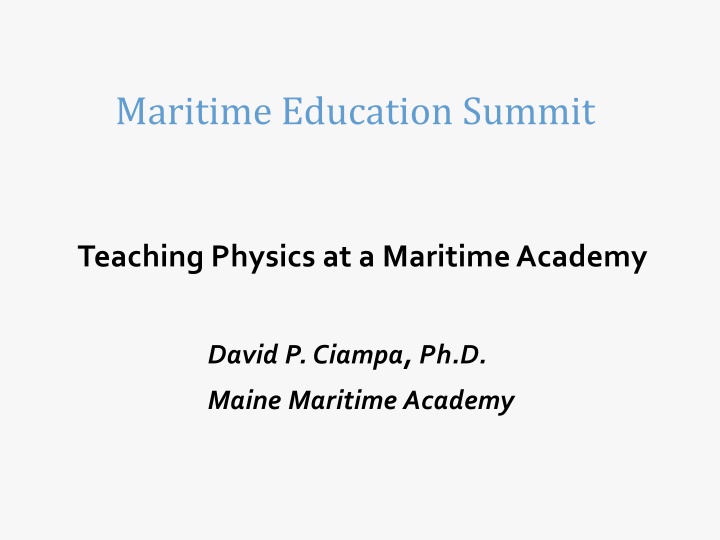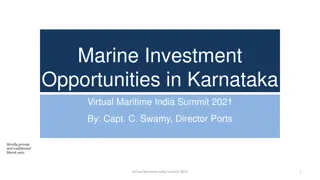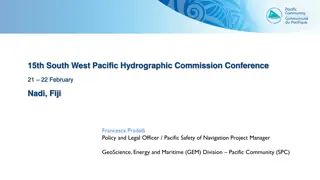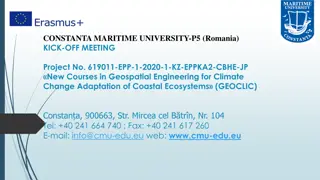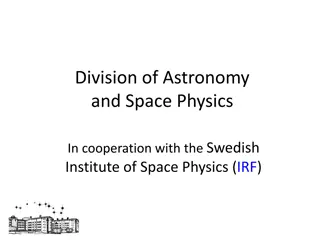Teaching Physics at Maritime Academy: Insights from Dr. David P. Ciampa, Ph.D.
Dr. David P. Ciampa, Ph.D., shares his experience teaching physics at a Maritime Academy emphasizing on problem-solving techniques, motivation strategies, and challenges encountered. He discusses the unique aspects of teaching physics in a maritime setting and offers insights into student engagement and success in the course.
Download Presentation

Please find below an Image/Link to download the presentation.
The content on the website is provided AS IS for your information and personal use only. It may not be sold, licensed, or shared on other websites without obtaining consent from the author.If you encounter any issues during the download, it is possible that the publisher has removed the file from their server.
You are allowed to download the files provided on this website for personal or commercial use, subject to the condition that they are used lawfully. All files are the property of their respective owners.
The content on the website is provided AS IS for your information and personal use only. It may not be sold, licensed, or shared on other websites without obtaining consent from the author.
E N D
Presentation Transcript
Maritime Education Summit Teaching Physics at a Maritime Academy David P. Ciampa, Ph.D. Maine Maritime Academy
Teaching Physics at a Maritime Academy David P. Ciampa, Ph.D. Maritime academy vs standard institution At the academy: Regimented lifestyle Emphasis on hands-on training Student mind-set tends to be more practical Shorter semesters
Teaching Physics at a Maritime Academy David P. Ciampa, Ph.D. Key to understanding physics and succeeding in the course: Solve physics problems lots of them!! Difficult to sell this concept to students I have no difficulty understanding the ideas; I just can t solve the problems.
Teaching Physics at a Maritime Academy David P. Ciampa, Ph.D. How to motivate students to do assigned problems? Grading homework is not an effective motivator Quizzes: One homework problem from those assigned
Teaching Physics at a Maritime Academy David P. Ciampa, Ph.D. Quiz scores and exam scores show a correlation
Teaching Physics at a Maritime Academy David P. Ciampa, Ph.D. Problem solving is a challenging art-form to master difficulties include: Lack of preparation in algebra Distinguishing between the physics and the algebra Translating from language to mathematical formulism The idea that we use a few basic equations and principles to solve a wide variety of problems Using dimensional analysis as a diagnostic Using a linear approach to the solution Telescoping between the overall flow and the details
Teaching Physics at a Maritime Academy David P. Ciampa, Ph.D. Problem # 25 (Chapter 21, Physics, Walker, 4th ed, Addison-Wesley) Two light-bulbs operate on the same potential difference. Bulb A has four times the power output of bulb B. (a.) Which bulb has the greater current passing through it? Explain. (b.) What is the ratio of the current in bulb A to the current in bulb B?
Teaching Physics at a Maritime Academy David P. Ciampa, Ph.D. Problem: (#17 Ch.4, Physics, by Walker, 4th ed, Addison-Wesley) A mountain climber jumps a 2.8-m-wide crevasse by leaping horizontally with a speed of 7.8m/s. (a.) If the climber s direction of motion on landing is -45o, what is the height difference between the two sides of the crevasse? (b.) Where does the climber land?
Teaching Physics at a Maritime Academy David P. Ciampa, Ph.D. Some techniques I have tried: Digital pen technology Effective for those who use it Cooperative grouping (sets of three students) Not effective as implemented Discussion-oriented presentation in class Limited effectiveness Conceptual post- and pre-tests Helpful as a diagnostic
Teaching Physics at a Maritime Academy David P. Ciampa, Ph.D. Flipped classroom: On-line lectures and problem-solving during class An interesting idea if the students are motivated A hybrid approach between traditional and flipped: 5-7 minutes of lecture followed by problem-solving; repeat Students solve problems during class I sample students work while they solve problems, allowing me to address the particular issues I observe
Teaching Physics at a Maritime Academy David P. Ciampa, Ph.D. Results of hybrid method (Spring 2014 data) compared with other semesters
Teaching Physics at a Maritime Academy David P. Ciampa, Ph.D. Spring 2014 students were neither more prepared nor did they perform better on the conceptual test than students from other semesters
